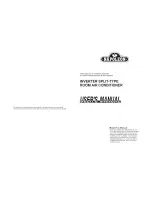
SiBE121135
Control Specification
Function and Control
109
For Heat Pump Model
1. Determine command frequency
Command frequency is determined in the following order of priority.
1. Limiting defrost control time
2. Forced cooling / heating
3. Indoor frequency command
2. Determine upper limit frequency
The minimum value is set as upper limit frequency among the frequency upper limits of the
following functions:
Compressor protection, input current, discharge pipe temperature, low Hz high pressure
limit, heating peak-cut, freeze-up protection, defrost.
3. Determine lower limit frequency
The maximum value is set as the lower limit frequency among the frequency lower limits of
the following functions:
Four way valve operation compensation, draft prevention, pressure difference upkeep.
4. Determine prohibited frequency
There is a certain prohibited frequency such as a power supply frequency.
Indoor Frequency Command (
∆
D signal)
The difference between a room thermistor temperature and the target temperature is taken as
the “
∆
D signal” and is used for frequency command.
Values depend on the type of indoor unit.
∗
Th OFF = Thermostat OFF
Indoor Unit Capacity (S value)
The capacity of the indoor unit is a “S” value and is used for frequency command.
Frequency Initial Setting
<Outline>
When starting the compressor, or when conditions are varied due to the change of the operating
room, the frequency must be initialized according to the total of a maximum
∆
D value of each
room and a total value of Q (
Σ
Q) of the operating room (the room in which the thermos is set to
ON).
Q value: Indoor unit output determined from indoor unit volume, airflow rate and other factors.
Temperature
difference (°C)
∆
D
signal
Temperature
difference (°C)
∆
D
signal
Temperature
difference (°C)
∆
D
signal
Temperature
difference (°C)
∆
D
signal
–2.0
∗
Th
OFF
0
4
2.0
8
4.0
C
–1.5
1
0.5
5
2.5
9
4.5
D
–1.0
2
1.0
6
3.0
A
5.0
E
–0.5
3
1.5
7
3.5
B
5.5
F
Ex:
Capacity
S value
Capacity
S value
2.5 kW
25
5.0 kW
50
3.5 kW
35
6.0 kW
60
















































